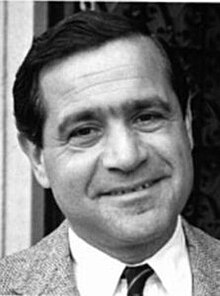Peter B. Neubauer
 From Wikipedia the free encyclopedia
From Wikipedia the free encyclopedia
Peter B. Neubauer | |
|---|---|
 | |
| Born | July 5, 1913 Krems an der Donau, Austria |
| Died | February 15, 2008 (aged 94) New York City, United States |
| Alma mater | University of Vienna, University of Bern |
| Scientific career | |
| Fields | Child psychiatry |
| Institutions | Bellevue Hospital, New York University, Jewish Board of Family and Children's Services |
Peter Bela Neubauer (July 5, 1913 – February 15, 2008) was an Austrian-born American child psychiatrist and psychoanalyst.
Life[edit]
The Neubauer family was part of a small Jewish community in Krems an der Donau, Austria, where Peter was born on July 5, 1913. He received his medical training at the University of Vienna and the University of Bern, in Switzerland, to which he escaped during the Nazi control of Austria. He completed his psychiatric training in Bern in 1941.
Neubauer died in New York City on February 15, 2008, at the age of 94.[1]
Career[edit]
Neubauer immigrated to New York in 1941,[1] where he took a position on the staff of Bellevue Hospital.[citation needed]
In an early influential paper, "The One-Parent Child and His Oedipal Development" (1960), Neubauer indicated that a father's absence could jeopardize child development as seriously as maternal deprivation.[2] He worked closely with Anna Freud at the Hampstead Clinic in London, and from the 1970s to his death, Neubauer was a co-editor of The Psychoanalytic Study of the Child, an annual publication of Yale University. He was one of the first to study the emotional impact on children witnessing violence in television and film.[1]
Neubauer's published books include Nature's Thumbprint: The New Genetics of Personality,[3] which includes some discussion of his controversial long-term study of adoptive Jewish twins (at least five sets) and triplets (one set) separated during infancy. Neither the children nor their adoptive parents were aware of the real reason they were all being studied or that the children had identical siblings.[4][5] Some of the twins eventually learned that their separation had been deliberate as a "nature versus nurture" experiment by Neubauer. These revelations led to controversy, anger, and ethical comparisons with notorious twin experiments by the same Nazi regime that Neubauer had escaped.[6] Some of the subjects of Neubauer's twin study have sought records, apologies and compensation from the Jewish Board of Family and Children's Services, which inherited Neubauer's study records. At least three of the separated siblings apparently died by suicide. The experiment was discussed in the 2007 memoir Identical Strangers: A Memoir of Twins Separated and Reunited by Elyse Schein and Paula Bernstein, as well as the documentary films The Twinning Reaction (2017)[5][7] and Three Identical Strangers (2018)[8] and the television episode Secret Siblings (2018).[9] At the conclusion of the study in 1980, Neubauer reportedly feared that public opinion would be against the study, and declined to publish it.[10] The records of the study are sealed at the Yale University Library until October 25, 2065,[11] although by 2018, some 10,000 pages had been released but were heavily redacted and inconclusive.[12]
Neubauer served as Director of the Jewish Board's Child Development Center, President of the Association for Child Psychoanalysis,[1] Clinical Professor of Psychiatry at New York University, and Secretary General of the International Association of Child Psychiatry and Allied Professions.
References[edit]
- ^ a b c d Pearce, Jeremy (March 3, 2008). "Peter B. Neubauer, 94, Noted Child Psychiatrist, Is Dead". New York Times.
- ^ The Psychoanalytic Study of the Child 15 (1960): 286, 287, 293, 295, 297, 298, 299, 302, 303, 305, 308.
- ^ Neubauer, Peter B.; Neubauer, Alexander (1990). Nature's Thumbprint: The New Genetics of Personality. Addison Wesley. ISBN 9780201092547.
- ^ Saul, Stephanie (January 31, 1998) [First published October 18, 1997]. "Separated Triplets Had Been Studied Since Birth". Newsday – via Greensboro News & Record.
- ^ a b "Twins make astonishing discovery that they were separated shortly after birth and then part of a secret study". ABC News. March 9, 2018.
Lori Shinseki, a documentarian and ABC News consultant... Of the at least 15 children believed to have been separated from twins or triplets by Louise Wise Services, some have reported serious mental health issues, according to Shinseki. She said it appears that at least three separated siblings committed suicide
- ^ Kardon, Gabrielle (March 16, 2018). "Life in triplicate". Science. 359 (6381): 1222. Bibcode:2018Sci...359.1222K. doi:10.1126/science.aat0954. S2CID 20387005.
The irony of a Jewish researcher and a Jewish adoption agency conducting a twin study after the atrocities waged against Jewish people in Nazi Germany is clear.
- ^ The Twinning Reaction: Official Site. Retrieved July 22, 2018
- ^ "A Sundance film about adoption hurls questions at a well-known charity". Washington Post. January 28, 2018.
- ^ "Secret Siblings". 20/20. March 9, 2018. ABC News. Retrieved January 7, 2019.
- ^ Bernstein, Paula; Schein, Elyse (October 25, 2007). "'Identical Strangers' Explore Nature Vs. Nurture" (Interview). Interviewed by Joe Richman. NPR. Retrieved January 7, 2019.
Ms. Schein: So the study ended in 1980. And then a year later, New York State began requiring adoption agencies to keep siblings together. Ms. Bernstein: And at that point, they realized public opinion would be so against them, that they wouldn't dare publish the study.
- ^ McCormack, William (October 1, 2018). "Records from controversial twin study sealed at Yale until 2065". Yale Daily News. Retrieved January 7, 2019.
- ^ Ryan, Patrick (26 June 2018). "Three Identical Strangers': How triplets separated at birth became the craziest doc of 2018". USA Today. Retrieved 30 Nov 2019.